
IRIS login | Reed College home Volume 95, No. 1: March 2016
Patterns of Power
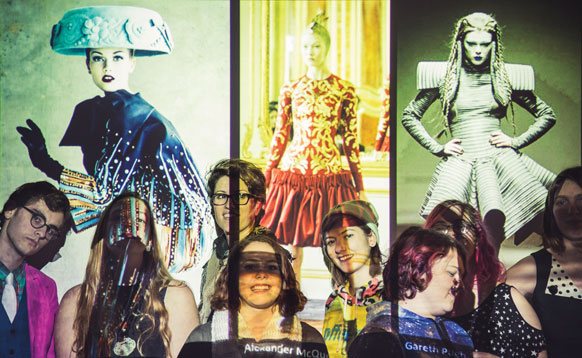
Photos by Matt D'Annunzio
How fashion reveals—and enforces—the hidden hierarchies of society
By Randall S. Barton
Miley Cyrus is wearing silver thigh-high boots. A high belt supports a loincloth of chains and cascading crystals. Gleaming leather straps streak across her breasts, inviting imminent wardrobe malfunction. Nicki Minaj sports a sheer, embroidered gown with a mermaid tail and a neckline that plunges to the belly-button. Justin Bieber shows off in skintight, distressed jeans, rough-out boots, and a black leather jacket—rather like something Bruce Springsteen might have worn in his glory days.
Millions of viewers around the globe tune into the Video Music Awards to gorge themselves on glamor, glitz, and gossip. But the students gathered around the conference table today are not here for entertainment. They are taking Theatre 220, History of Clothing in Society and Performance, and they have come to deconstruct the fashions on display at the award show.
“Miley’s outfit was very in-your-face,” a student comments. “It was revealing in a way that was meant to make you feel uncomfortable and question why it was revealing. The accessories she wore were equally as loud as the outfit.”

Students deconstruct Britney Spears’s outfit at a glitzy glamor event.
Prof. Chloe Chapin [theatre 2015–] pauses. “What does the word ‘loud’ mean?”
“Attention-grabbing?” the student ventures.
“That’s great,” Prof. Chapin offers. “Break it down for us so we understand what it is you’re talking about. What is she wearing?”
“An apron with straps,” comes the reply.
“It reminded me of suspenders, or lederhosen,” says another.
“Yes,” Chapin says. “It’s sort of like 19th-century Germany meets The Jetsons.”
It’s something of a paradox. Outfits like the ones on display at the VMA show are designed to grab attention, but fashion in general has not traditionally attracted the same kind of attention that scholars have paid to theatre, art, or literature. This is a shame, according to Chapin. Clothing, she argues, represents an extraordinarily rich field of study, weaving together a fascinating tapestry of history, economics, politics, anthropology, and art. Clothing may conceal, but it can also reveal how people in various eras and cultures have chosen to project elements of their identity.
“Fashion is one of the great pillars of being human,” Chapin says. “If the things we need are food, shelter, and clothing, how can we talk about society and culture without talking about clothing?”
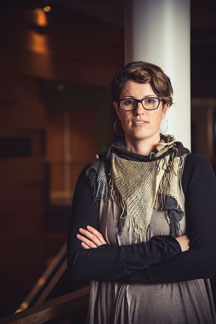
Prof. Chapin looks at the evolution of hairstyles and the tuxedo for insight into deeper historical forces.
Professor, artist, costume designer, and fashion historian, Chapin has designed for theater, opera, and dance. She has a BFA in performance production from Cornish College of the Arts, an MFA in Costume Design from the Yale School of Drama, and an MA in Fashion and Textile Studies from the Fashion Institute of Technology. She taught fashion history at FIT for nine years, and has lectured at Yale, NYU, Barnard, and Stockholm University. She was a 2012 MacDowell Fellow and a 2014 Fulbright Scholar. She was interviewed for a recent Freakonomics episode about why suspenders went out of style. She has also taught several classes at Paideia, including one on the history of hairstyles and another on James Bond and the tuxedo.
The professor’s tailored trousers and blazer reflect her interest in the history of men’s suits. Her hair was cut by the barber who advised hairdressers on Boardwalk Empire how to capture the look of a man’s haircut from the early 1920s.
“It’s interesting teaching at Reed, where the students are so smart and interested in looking at things through an academic lens,” Chapin says. “They want more reading and more challenging theory.”
Sociology major Sierra Swann ’17 took the course to learn the role that fashion plays in capitalism. “Fashion is integral to how societies and cultures conduct themselves,” she says. “People relate to each other based on what they look like and what they’re wearing.”
Fine and Dandy
The French Revolution gave rise to a dramatic transformation in men’s fashion known as the Great Masculine Renunciation.
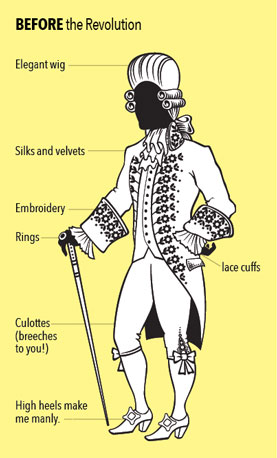
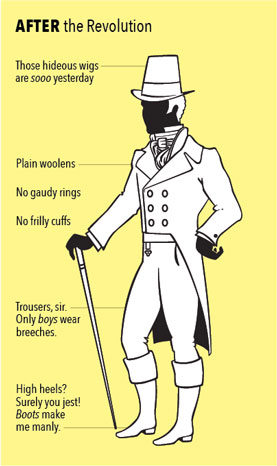
illustrations by Allen Crawford
Chapin’s class offers a lively tour of trends and fashions through the ages. Students travel back to a time when people lived in caves and draped their bodies with animal skins. They learn the difference between patterns, fibers, and weaves. (Wool is a fiber, flannel is a weave, and plaid is a pattern.) They discover that some of the first laws in colonial America were sartorial laws regulating dress. A woman could be arrested for having gold trim on her bodice, for example, because it was forbidden to wear clothes above your station. In 1660, Virginia colonists were forbidden to import “silke stuffe in garments or in peeces except for whoods or scarfs, nor silver nor gold lace, nor bone lace of silk or threads, nor ribbands wrought with gold or silver in them.”
They also ask how fashion reveals—and sometimes reinforces—patterns of power in society.
Take, for example, the Great Masculine Renunciation, a tectonic shift in the presentation of menswear following the American and French Revolutions. Before the 1790s, men in Europe typically dressed with the same goals as women. Power dressing was all about ostentation, draping the body with extravagant silks, velvets, and embroidery. Men wore perfume, powdered wigs, high heels, lace cuffs, and jewelry. Picture the Sun King and his court at Versailles. But after the French Revolution, aristocratic finery was suddenly seen as horribly outdated. The culottes (knee breeches) of the royal court became such a powerful symbol of the despised ancien régime that working-class partisans of the Revolution were known as the sansculottes (without breeches) because they wore trousers. Menswear became more practical. Instead of dressing like peacocks, men began to adopt sober woolens in shades of black, brown, gray, and blue. Boots replaced embroidered heels.
To ask, “Why did this happen?” is to plunge headlong into the theory of fashion, prompting discussion about the rise of humanism and neoclassicism, the shift from palace living to urban life, and the Anglomania that seized the Continent after the French Revolution. It also invites comparison with contemporary ideas about masculinity, male fashion, and the presentation of self.
Hair Today,
Gone Tomorrow
In 1937, renowned fashion historian James Laver created a timeline, often referred to as Laver’s Law, to describe how we experience fashion, based on the observer’s distance from the costume in question. Fashion, he said, is:
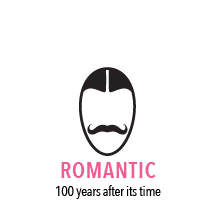
Illustrations by Allen Crawford
“Fashion doesn’t happen on its own,” Chapin reminds her students. “It is always in context, always in response to what comes before it.”
After the horrifying devastation of World War I and the 1918 influenza pandemic, for example, the ’20s witnessed new fashions that were widely considered outrageous: bobbed haircuts, dropped waists, and the shortest skirts seen on women’s clothing in thousands of years. “Panic and mania often contribute to big shifts,” she explains. “While there is rarely a clear case of cause and effect, you can argue that war, plague, and death often precede an explosion of self-expression that is reflected in lavishness in fashion. And then you have a reaction against this boyish garçon look in the more feminine styles of the ’30s, with longer hemline and draped, bias-cut gowns.”
While people typically use decades—the ’60s, the ’80s—as a kind of shorthand to refer to fashion trends, Chapin points out that the trends that later become “iconic” often aren’t popular until halfway through the decade. Bell-bottom jeans and tie-dyed shirts, for example, the mainstays of any back-to-the-’60s party, didn’t catch on until 1966 or so.
Getting her master’s degree at the Yale School of Drama, Chapin says, “was like getting a degree in English, except instead of using words, I used costumes. It was literary analysis put up on its feet.”
One hallmark of a Reed education is the ability to transcend intellectual disciplines; to take insights from psychology and apply them to King Lear, or use dance steps to explain Brownian motion. That philosophy certainly applies to the theatre department, which offers courses on improvisation, race and identity, and performance and activism in South Africa, in addition to more traditional courses like acting, directing, playwriting, and dramaturgy.
During one classroom exercise, Chapin asks the students to work as a group, placing 18 fashion silhouettes in chronological order. The puzzle prompts a discussion about the evolution of the bustle until all the pieces are correctly placed but one, an errant silhouette resembling Little Bo Peep, from the 1830s.
Every student works on a final project that relates to fashion and its subcultures. One student takes on the iconography of pizza. Another covers non-binary-gendered fashion, while a third delves into the emerging “Health Goth” trend. (Yes, this is a thing. Look it up.) These projects give students practice in synthesizing huge amounts of information into a coherent narrative. They also sharpen the students’ ability to separate historical fact from media hype.
“In fashion journalism, they always want the origin story,” Chapin says. “So-and-so was the first person to invent this, which is usually not the case when it comes to fashion. It’s not always very good writing and generally doesn’t have sources.”
In the final weeks of the class, the study turns to the 20th century, when the individuals who designed clothes often overshadowed the people who wore them. Students prepare presentations on specific designers, illustrating how their work continues to influence fashion today.
Having entered the sixth year of the ought-teens, it is interesting to ponder; will this year’s fashions be what people later remember about this decade? Ombréd hair and sleeve tattoos? Or has the internet accelerated the pace of what’s hot and what’s not so dramatically that categorizing fashion by decade no longer makes sense?
Back in class, the screen displays a photo of a bronzed Britney Spears at the Video Music Awards clad in a shimmering skintight minidress spangled with gold and silver sequins, her hair pulled high.
The students issue a collective groan. And the discussion begins in earnest.
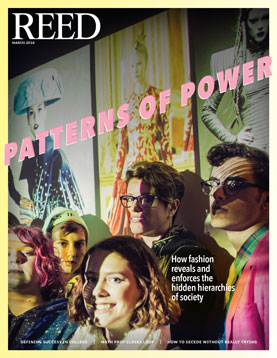
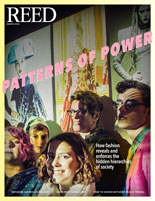
LATEST COMMENTS
steve-jobs-1976 I knew Steve Jobs when he was on the second floor of Quincy. (Fall...
Utnapishtim - 2 weeks ago
Prof. Mason Drukman [political science 1964–70] This is gold, pure gold. God bless, Prof. Drukman.
puredog - 1 month ago
virginia-davis-1965 Such a good friend & compatriot in the day of Satyricon...
czarchasm - 4 months ago
John Peara Baba 1990 John died of a broken heart from losing his mom and then his...
kodachrome - 7 months ago
Carol Sawyer 1962 Who wrote this obit? I'm writing something about Carol Sawyer...
MsLaurie Pepper - 8 months ago
William W. Wissman MAT 1969 ...and THREE sisters. Sabra, the oldest, Mary, the middle, and...
riclf - 10 months ago